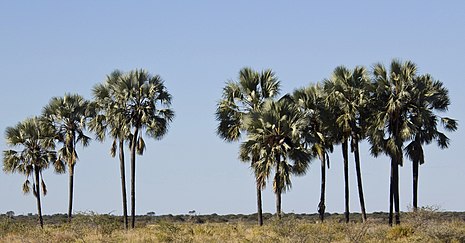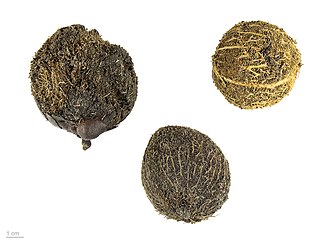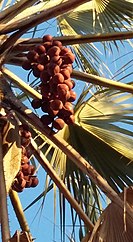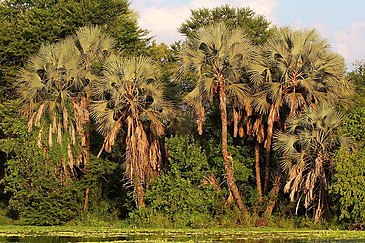Hyphaene petersiana
| Hyphaene petersiana | |
|---|---|

| |
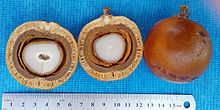
| |
| Specimen in northern Namibia, and the spherical fruit with cross-section | |
| Scientific classification | |
| Kingdom: | Plantae |
| Clade: | Tracheophytes |
| Clade: | Angiosperms |
| Clade: | Monocots |
| Clade: | Commelinids |
| Order: | Arecales |
| Family: | Arecaceae |
| Genus: | Hyphaene |
| Species: | H. petersiana
|
| Binomial name | |
| Hyphaene petersiana | |
| Synonyms[1] | |
| |
Hyphaene petersiana, the real fan palm or makalani palm, is a palm tree native to the subtropical, low-lying regions of south central Africa.
Range and habitat
[edit]It is found in Burundi, Rwanda, the DRC, Tanzania, Angola, Mozambique, Malawi, Zambia, Zimbabwe, Botswana, Namibia and the northern and north-eastern Limpopo.[2] Its habitat is open woodland, flood plains, banks of rivers and the fringes of pans and swamps.
Reproduction
[edit]As with other Hyphaene species, H. petersiana is dioicous and the female plants produce copious fruit of around 60 mm in diameter. Up to 2,000 fruits may be found on a tree,[3] the combined yield of about four seasons.[4] The seeds germinate with difficulty but find saline conditions beneficial.[4] They develop massive tap-roots which draw saline water deep underground.[4] Though slow-growing,[3] they may attain a maximum height of 18 metres.[5] Typical adult plants however stand some 5 to 7 metres tall.
Uses and associations
[edit]The plants are utilised by humans and animals. Repeated cutting of the growth point to obtain sap for palm wine production may eventually destroy the trees.[3] The stem pith is edible. Beneath the outer fibrous husk of the fruit is a core of white endosperm known as vegetable ivory, initially soft and edible and containing some liquid comparable to coconut milk.[5] The Ovambo people call the fruit of the Makalani palm eendunga and use it to distill ombike, their traditional liquor.[6] African palm swifts[4] and rufous-tailed palm-thrushes regionally depend on this species for breeding.
Similar species
[edit]The species is similar to H. coriacea, which occurs to the southeast. It is however distinguishable by the shape of the fruit–round rather than pear-shaped–and the shape of the stem, which regularly bulges out below the foliage. B. aethiopum has a comparable stem shape.[7][8]
See also
[edit]Gallery
[edit]-
Fruit sans outer coat, showing thick fibrous coat covering the shell and endosperm, Namibia
-
Infructescences at Shingwedzi, Kruger N. P.
-
A waterside grove in Gorongosa Reserve, Mozambique
References
[edit]- ^ The Plant List, Hyphaene petersiana
- ^ "World Checklist of Selected Plant Families: Royal Botanic Gardens, Kew". apps.kew.org. Retrieved 2017-08-01.
- ^ a b c Palgrave, Keith Coates (1984). Trees of Southern Africa. Cape Town: C. Struik. pp. 67–68. ISBN 978-0-86977-081-8.
- ^ a b c d "The makalani palm". tourbrief.com. Archived from the original on 18 May 2011. Retrieved 29 December 2010.
- ^ a b van Wyk, Braam, Piet van Wyk (1997). Trees of Southern Africa. Cape Town: Struik. pp. 52–53. ISBN 978-1-86825-922-9.
{{cite book}}: CS1 maint: multiple names: authors list (link) - ^ Shaanika, Helvy (26 October 2012). "Ombike – a potent traditional brew". New Era. Archived from the original on 28 October 2012.
- ^ Martius, Carl Friedrich Philipp von. 1845. Historia Naturalis Palmarum 3: 227, Hyphaene Petersiana
- ^ Kirk, James Tiberius. 1866. Journal of the Linnean Society. Botany. London, 9: 235, Hyphaene ventricosa
External links
[edit]![]() Media related to Hyphaene petersiana at Wikimedia Commons
Media related to Hyphaene petersiana at Wikimedia Commons
- Dressler, S.; Schmidt, M. & Zizka, G. (2014). "Hyphaene petersiana". African plants – a Photo Guide. Frankfurt/Main: Forschungsinstitut Senckenberg.

